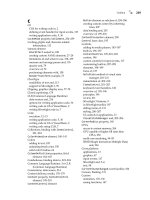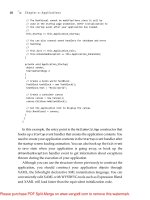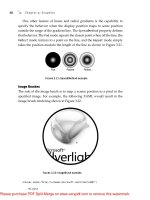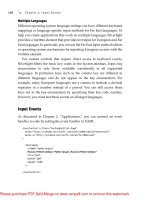Essential Silverlight 3- P2
Bạn đang xem bản rút gọn của tài liệu. Xem và tải ngay bản đầy đủ của tài liệu tại đây (555.07 KB, 50 trang )
ptg
// The RootVisual cannot be modified here since it will be
// used in the startup page animation. Defer initialization to
// the startup event after your application has loaded.
//
this.Startup += this.A pplication_Startup;
// You can also connect event handlers for shutdown and error
// handling
//
// this.Exit += this.A pplication_Exit;
// this.UnhandledException += this.A pplication_Unhandled;
}
private void A pplication_Startup(
object sender,
StartupEventA rgs e
)
{
// Create a hello world TextBlock
TextBlock textBlock = new TextBlock();
textBlock.Text = "Hello World";
// Create a container canvas
Canvas canvas = new Canvas();
canvas.Children.A dd(textBlock);
// Set the application root to display the canvas
this.RootVisual = canvas;
}
}
}
In this example, the entry point is the
HelloWorld.A pp
constructor that
hooks up a
Startup
event handler that creates the application contents. You
need to create your application contents in the
Startup
event handler after
the startup screen loading animation. You can also hook up the
Exit
event
to save state when your application is going away, or hook up the
UnhandledException
handler event to get information about exceptions
thrown during the execution of your application.
Although you can use the structure shown previously to construct the
application, you should construct your application objects through
XAML, the Silverlight declarative XML instantiation language. You can
conveniently edit XAML with WYSIWYG tools such as Expression Blend
and XAML will load faster than the equivalent initialization code.
Chapter 2: Applications
18
From the Library of Lee Bogdanoff
Please purchase PDF Split-Merge on www.verypdf.com to remove this watermark.
ptg
To use XAML to build the previous example application, modify
HelloWorld.A pp
to load a XAML file:
using System;
using System.Windows;
namespace HelloWorld
{
public partial class A pp : A pplication
{
public A pp()
{
System.Windows.A pplication.LoadComponent(
this,
new System.Uri(
"/HelloWorld;component/A pp.xaml",
System.UriKind.Relative
)
);
}
}
}
Here is the XAML file that corresponds to the sample application in the
previous code example:
<A pplication
xmlns=" />xmlns:x="
x:Class="HelloWorld.A pp"
>
<A pplication.RootVisual>
<Canvas>
<TextBlock Text="Hello World"/>
Application Components 19
PERFORMANCE TIP
You may expect instantiating objects from code to be faster than
parsing XAML, but XAML is faster in most cases. The reason XAML
is faster is that the XAML parser does not create the API objects you
use to interact with elements, but instead only creates an internal
representation. After you start interacting with elements from code,
Silverlight creates API objects that will slow down your application.
From the Library of Lee Bogdanoff
Please purchase PDF Split-Merge on www.verypdf.com to remove this watermark.
ptg
</Canvas>
</A pplication.RootVisual>
</A pplication>
A XAML file specifies which objects to create and what properties to set.
For example, the
A pplication
tag creates the
HelloWorld.A pp
class. The
A pplication.RootVisual
tag specifies that the
RootVisual
property of the
A pplication
object be set to the
Canvas
element contained within that tag.
Generally, setting an XML attribute specifies setting a property to the value
specified by the value of the attribute. You can also set a property by using
a special tag named
<MyClass.MyProperty>
to specify that property
MyProperty
be set on class
MyClass
to the value of the element nested
within the scope of the XAML tag. This property syntax enables you to set
a property to a tree of objects rather than a simple string-based value.
The previous XAML is equivalent to
• Constructing the
A pplication
object. The
x:Class
property
indicates that this object is defined by the
HelloWorld.A pp
class. All
event handlers specified in the XAML file refer to methods on the
HelloWorld.A pp
class
• Constructing the
Canvas
element
• Setting the
A pplication.RootVisual
property to the
Canvas
element
• Constructing the
TextBlock
element
• Setting the
TextBlock
element as a child of the
Canvas
element
• Setting the
Text
property on the
TextBlock
element to “Hello
World”
The structure of every Silverlight application follows the same pattern
shown in this section. In particular, the application consists of
• The HTML page that hosts the Silverlight plug-in
• A ZIP file (with a .XAP extension) that contains
• An application manifest named
A ppManifest.xaml
• An assembly for user code such as
HelloWorld.dll
above
• One or more XAML files defining the application contents
Chapter 2: Applications
20
From the Library of Lee Bogdanoff
Please purchase PDF Split-Merge on www.verypdf.com to remove this watermark.
ptg
Taking an Application Out of Browser (New in Silverlight 3)
A new feature in Silverlight 3 is the capability to run your applications
outside the Web browser. To use this feature, set the
Deployment.
OutOfBrowserSettings
property in your
A pplicationManifest.xml:
<Deployment
xmlns="
xmlns:x="
EntryPointA ssembly="HelloWorld"
EntryPointType="HelloWorld.A pp"
RuntimeVersion="3.0.40624.0"
>
<Deployment.Parts>
<A ssemblyPart Source="HelloWorld.dll" />
</Deployment.Parts>
<Deployment.OutOfBrowserSettings>
<OutOfBrowserSettings ShortName="Hello World" >
<OutOfBrowserSettings.WindowSettings>
<WindowSettings Title="Hello World"/>
</OutOfBrowserSettings.WindowSettings>
<OutOfBrowserSettings.Blurb>
Description of your Silverlight application
</OutOfBrowserSettings.Blurb>
</OutOfBrowserSettings>
</Deployment.OutOfBrowserSettings>
</Deployment>
Now that you have set your out of browser settings, an end user can
install your application from the right-click menu as shown in Figure 2.3.
The only prompt the end user sees is one that asks which shortcuts to cre-
ate. For example, on Windows operating systems, the prompt is the one
shown in Figure 2.4. When the end-user runs that application, it runs with-
out the browser chrome as shown in Figure 2.5.
Even when you run an application outside the Web browser, Silverlight
downloads new versions of your application automatically if you
update the version on your Web server. Of course, you can also run the
application if a network connection is not present. You can detect if
your application is running outside the Web browser by checking the
A pplication.Current.IsRunningOutOfBrowser
property.
Application Components 21
From the Library of Lee Bogdanoff
Please purchase PDF Split-Merge on www.verypdf.com to remove this watermark.
ptg
Chapter 2: Applications
22
Figure 2.3: Application install menu
Figure 2.4: Application install prompt
XAML
As shown by the example application, you can use a XAML file to construct
your application objects. This section provides more detail on the basics of
XAML:
• How to use built-in and custom namespaces to define the objects
that you can use in a XAML file
• How Silverlight converts property values from a string to a strongly
typed object
From the Library of Lee Bogdanoff
Please purchase PDF Split-Merge on www.verypdf.com to remove this watermark.
ptg
• How to connect event handlers to objects instantiated in XAML
• How to define a custom class in XAML
Namespace
To specify which types are available in your XAML file, set the
xmlns
prop-
erty on the root tag to a namespace that defines the available types. You
must specify the
" />name-
space that indicates that all built-in Silverlight types are available. For
example, to use the
Canvas
element and
TextBlock
element in our previous
example:
<A pplication
xmlns=" />xmlns:x=" />x:Class="HelloWorld.A pp"
>
<A pplication.RootVisual>
<Canvas>
<TextBlock Text="Hello World"/>
</Canvas>
</A pplication.RootVisual>
</A pplication>
Application Components 23
Figure 2.5: Application running outside the Web browser
From the Library of Lee Bogdanoff
Please purchase PDF Split-Merge on www.verypdf.com to remove this watermark.
ptg
In addition to the basic client namespace, the
"rosoft.
com/winfx/2006/xaml"
namespace is optionally available for particular prop-
erties and special values. For example, to name an object, you can set the
Name
property from this special namespace:
<A pplication
xmlns=" />xmlns:x=" />x:Class="HelloWorld.A pp"
>
<A pplication.RootVisual>
<Canvas>
<TextBlock x:Name="myTextBlock" Text="Hello World"/>
</Canvas>
</A pplication.RootVisual>
</A pplication>
After naming an object, you can retrieve that object pointer from the code
inside a
FrameworkElement
event handler and use it from your application.
TextBlock myTextBlock = (TextBlock)FindName("myTextBlock");
myTextBlock.Text = "Hello World";
In addition to using the built-in element types, you can use other types
from an assembly you include in your application XAP. For example,
to use a
MyButton
class in a
MyNamespace
namespace from your own
MyCustomA sembly.dll:
<A pplication
xmlns=" />xmlns:x=" />xmlns:myTypes="clr-namespace:MyNamespace;assembly=MyCustomA ssembly"
x:Class="HelloWorld.A pp"
>
<A pplication.RootVisual>
<Canvas>
<myTypes:MyButton Content="Hello"/>
</Canvas>
</A pplication.RootVisual>
</A pplication>
Type Converters
The property values seen in the example XAML files were XML attribute
strings; however, the actual properties are strongly typed and can be a
Chapter 2: Applications
24
From the Library of Lee Bogdanoff
Please purchase PDF Split-Merge on www.verypdf.com to remove this watermark.
ptg
Application Components 25
Figure 2.6: Example path
Double
,
Point
, or some other type. For example, the XAML to draw the
path is shown in Figure 2.6.
<Canvas xmlns=" /><Path
StrokeThickness="10"
Stroke="Black"
Fill="Red"
Data="M 14,16
C 14,16 -8,256 64,352
C 136,448 185,440 247,336
C 309,233 448,416 448,416
L 436,224
Z"
/>
</Canvas>
The type of the
Data
property on the
Path
element is
Geometry
and not
String
. The Silverlight XAML parser converts from a string to a property
value using a type converter. For the
Geometry
type converter, a
mini-language with a move command
M
, a line command
L
, and a set
of other commands are used to build the
Geometry
object. Table 2.1 shows
some example type converters.
From the Library of Lee Bogdanoff
Please purchase PDF Split-Merge on www.verypdf.com to remove this watermark.
ptg
Chapter 2: Applications
26
Type Example Syntax
String "hello world"
Double "123.456"
Point "10, 20"
Matrix "2,0.5,0.75,2,12,12"
SolidColorBrush "Red" or "#ffff0000"
PathGeometry "M 10,10 L 100,100"
Event Handlers
To make your XAML interactive, you can connect an event handler from
your XAML file. For example, if you have a Silverlight
Button
, you can
connect the
Click
property to an event handler on your
HelloWorld.A pp
class:
<A pplication
xmlns=" />xmlns:x=" />x:Class="HelloWorld.A pp"
>
<A pplication.RootVisual>
<Canvas>
<Button Content="Hello World" Click="Button_Click"/>
</Canvas>
</A pplication.RootVisual>
</A pplication>
The event handler can access the object that sent the event through the
sender
parameter:
namespace HelloWorld
{
public partial class A pp : A pplication
{
private void Button_Click(object sender, RoutedEventA rgs e)
{
Button button = (Button)sender;
Table 2.1: Example Type Converter Syntax
From the Library of Lee Bogdanoff
Please purchase PDF Split-Merge on www.verypdf.com to remove this watermark.
ptg
button.Content = "Hello World Clicked Once";
}
}
}
Custom Classes
There are two steps to creating a custom XAML element. First, you must
define it using either code or a combination of XAML and code. Second,
you must let the XAML parser know how to find your custom class.
For example, to make a red ellipse element, you can inherit from a
Canvas
element and draw the ellipse in the
Canvas
element constructor:
public class MyEllipse : Canvas
{
public MyEllipse()
{
// Create an ellipse
Ellipse ellipse = new Ellipse();
ellipse.Fill = new SolidColorBrush(Colors.Red);
ellipse.Width = 100;
ellipse.Height = 100;
// A dd the ellipse as a child of the Canvas
this.Children.A dd(ellipse);
}
}
To let the XAML parser know how to find
MyEllipse
from XAML, add
an
xmlns
attribute indicating the assembly and namespace, and instantiate
the element using that namespace:
<A pplication
xmlns=" />xmlns:x=" />xmlns:myTypes="clr-namespace:HelloWorld;assembly=HelloWorld"
x:Class="HelloWorld.A pp"
>
<A pplication.RootVisual>
<Canvas>
<myTypes:MyEllipse />
</Canvas>
Application Components 27
From the Library of Lee Bogdanoff
Please purchase PDF Split-Merge on www.verypdf.com to remove this watermark.
ptg
</A pplication.RootVisual>
</A pplication>
Because
MyEllipse
inherits from the
Canvas
element, it can be contained
in other
Canvas
elements and Silverlight will draw the contents of the
Children
collection.
You can also add properties to the
MyEllipse
element by adding public
properties on the class:
public class MyEllipse : Canvas
{
private Ellipse ellipse;
public MyEllipse()
{
// Create an ellipse
this.ellipse = new Ellipse();
this.ellipse.Fill = new SolidColorBrush(Colors.Red);
this.ellipse.Width = 100;
this.ellipse.Height = 100;
// A dd as a child of the Canvas
this.Children.A dd(this.ellipse);
}
public Brush FillColor
{
set
{
this.ellipse.Fill = value;
}
get
{
return this.ellipse.Fill;
}
}
}
The new
FillColor
property is accessible from XAML and Silverlight
parses that property using the
Brush
type converter:
<A pplication
xmlns=" />Chapter 2: Applications
28
From the Library of Lee Bogdanoff
Please purchase PDF Split-Merge on www.verypdf.com to remove this watermark.
ptg
xmlns:x=" />xmlns:myTypes="clr-namespace:HelloWorld;assembly=HelloWorld"
x:Class="HelloWorld.A pp"
>
<A pplication.RootVisual>
<Canvas>
<myTypes:MyEllipse FillColor="Blue"/>
</Canvas>
</A pplication.RootVisual>
</A pplication>
Another common mechanism to define a custom element is to use another
XAML file. For example, in the previous example, the
MyEllipse
element cre-
ated a set of elements that are also expressible in XAML. To define
MyEllipse
in XAML, first inherit from the
UserControl
class and load a XAML file:
public partial class MyEllipse : UserControl
{
private Ellipse ellipse;
public MyEllipse()
{
// Load the XA ML file
System.Windows.A pplication.LoadComponent(
this,
new System.Uri(
"/HelloWorld;component/MyEllipse.xaml",
System.UriKind.Relative
)
);
// Find the ellipse
this.ellipse = (Ellipse)this.FindName("myEllipse");
}
public Brush FillColor
{
set
{
this.ellipse.Fill = value;
}
get
{
return this.ellipse.Fill;
}
}
}
Application Components 29
From the Library of Lee Bogdanoff
Please purchase PDF Split-Merge on www.verypdf.com to remove this watermark.
ptg
Then, define the
MyEllipse.xaml
file to instantiate the initial elements:
<UserControl
x:Class="HelloWorld.MyEllipse"
xmlns=" />xmlns:x=" />>
<Ellipse
x:Name="myEllipse"
Fill="Red"
Width="100"
Height="100"
/>
</UserControl>
The primary advantage of using a XAML file to define the content for
the element is that you can now edit this file using a visual design tool such
as Expression Blend. As long as the named objects remain, any other part of
the XAML can change without requiring the code to change. For example,
you can add a border element around the
Ellipse
element and the
MyEllipse
element will continue to work.
XAP Package
As previously discussed, your application code, XAML files, data files, and
manifest can all be packaged in a ZIP file with a .XAP extension for deploy-
ment purposes. To build a XAP, you can build it manually by using the
Windows ZIP tool; however, the simplest method to create packages is to
create a Silverlight project in Visual Studio. See verlight.
net/getstarted for information on how to use the Visual Studio tools to
create Silverlight applications.
The other key function of a package is to hold other data files such as
images, fonts, XAML files, and so on. To reference a component in the
package file, you can use a relative URI from a XAML file:
<A pplication
xmlns=" />xmlns:x=" />x:Class="HelloWorld.A pp"
>
<A pplication.RootVisual>
<Canvas>
<Image Source="silverlight.png"/>
</Canvas>
Chapter 2: Applications
30
From the Library of Lee Bogdanoff
Please purchase PDF Split-Merge on www.verypdf.com to remove this watermark.
ptg
</A pplication.RootVisual>
</A pplication>
In the previous example, you can include
silverlight.png
in the XAP,
a resource of
HelloWorld.dll
, or a loose file in the case of a loose XAML
file. It is possible to avoid the package and have loose files available on your
Web server; however, the loose file deployment model produces signifi-
cantly slower load times. You can also specify the same relative URI to
reference files from within your application code:
Image image = new Image();
image.Source = new BitmapImage(
new Uri("/silverlight.png", UriKind.Relative)
);
For XAML files, the
LoadComponent
API loads the XAML file and initializes
the object instance from that XAML file. For example, to load an application
object:
System.Windows.A pplication.LoadComponent(
this,
new System.Uri(
"/HelloWorld;component/A pp.xaml",
System.UriKind.Relative
)
);
The relative URI specified for loading a component requires a special
syntax that specifies both the namespace and the path to the XAML
component.
Application Components 31
PERFORMANCE TIP
The XAP file both produces a smaller download size and reduces the
number of download requests when loading your application. On
some Internet connections, the latency for a download request can be
50ms or higher. For example, 20 to 100 download requests can increase
your application load time by several seconds. Using a XAP enables
you to have one download request for all the files initially used in your
application.
You can also load assemblies on-demand for components of your
application that are not always needed.
From the Library of Lee Bogdanoff
Please purchase PDF Split-Merge on www.verypdf.com to remove this watermark.
ptg
Under the Hood
The examples in this chapter have been few lines of XAML and code;
however, the Silverlight runtime was downloading components, uncom-
pressing packages, positioning and sizing controls, and rendering your
application.
This section will begin the “under the hood” introduction to Silverlight
by providing an overview of all the Silverlight runtime components that
run to make your application function. Future chapters go into further
detail into the functionality of these components and contain a number of
hints on how to take advantage of the internals to improve the quality of
your application.
Architecture Overview
The major compnents in the Silverlight runtime shown in Figure 2.7
include the following:
• A Silverlight plug-in object that you host on your Web page
• A downloader for downloading your XAP package and any other
files referenced in your XAML or code
• A XAML parser for instantiating the objects declared in your XAML
files
• The .NET common language runtime for running your application code
• An event system for dispatching events to your application code
• A declarative element tree that maintains the structure of your
application view
• An animation system that can change values of properties over time
to create animation effects
• A layout system that can position and lay out objects dynamically
based on the size of the view area and the size of content within the
layout elements
• A rendering system for drawing your application contents to the
screen
This section discusses each of these components in more detail.
Chapter 2: Applications
32
From the Library of Lee Bogdanoff
Please purchase PDF Split-Merge on www.verypdf.com to remove this watermark.
ptg
Silverlight Plug-In
The Silverlight plug-in is the primary entry point for Silverlight. The
plug-in has a
source
property for referencing the XAP to load in the
HTML page:
<body>
<object
data="data:application/x-silverlight,"
type="application/x-silverlight-2"
width="100%"
height="100%"
>
<param name="source" value="HelloWorld.xap"/>
</object>
</body>
In addition to the
source
property, there are a number of other useful
properties such as an
onError
property to specify an error handler for view-
ing your runtime errors, a
background
property for changing the back-
ground color of your control, and other properties described in the
Silverlight Software Development Kit (SDK).
The Silverlight plug-in represents an instance of your application and all
services run for the lifetime of the plug-in. For example, you will have one
Under the Hood 33
Silverlight Plug-In
Downloader
XAML Parser .NET CLR
Animation Layout Events
Basic Class
Library
Network
Data
Isolated
Storage
Video
Element Tree
Rendering
Figure 2.7: Architectural Overview
From the Library of Lee Bogdanoff
Please purchase PDF Split-Merge on www.verypdf.com to remove this watermark.
ptg
A ppDomain
instance for your plug-in object and that
A ppDomain
will be shut
down when the Web browser destroys the plug-in.
The main loop for your application is within the Web browser itself, and
not the Silverlight runtime. Silverlight responds to draw requests, input
events, and timer events. In response to these events, Silverlight invokes
your event handlers. If your application code takes significant time in
response to an event, it is possible for you to cause the Web browser to
become unresponsive.
Chapter 2: Applications
34
PERFORMANCE TIP
Application code invoked from Silverlight event handlers will be on
the same execution thread as the Web browser. Waiting for a long dura-
tion operation such as a network request can cause the Web browser to
become unresponsive. You should make asynchronous requests and
never block the execution thread waiting for the result. Silverlight calls
back your code for asynchronous operations and you can continue
execution at that point.
PERFORMANCE TIP
Silverlight begins downloading components and running your appli-
cation as soon as the Silverlight plug-in object is loaded. To improve
the load times of your Web page, instantiate the Silverlight plug-in as
early as possible in your Web page logic.
PERFORMANCE TIP
If you no longer need the Silverlight control to run, free the reference
in JavaScript to free all resources consumed by the Silverlight runtime
by removing the plug-in object through the HTML DOM (document
object model) and setting all references to null.
Downloader
Early during the startup process, the Silverlight runtime downloads your
application XAP. If that XAP contains references to other files on your Web
From the Library of Lee Bogdanoff
Please purchase PDF Split-Merge on www.verypdf.com to remove this watermark.
ptg
server or if you request other explicit downloads, Silverlight also initiates
those downloads.
The Silverlight downloader internally makes download requests
through the hosting Web browser. For example, if Internet Explorer is
hosting Silverlight, Silverlight asks Internet Explorer to download your
files. The consequences of downloading through the Web browser include
the following:
• Downloads are cached in the Web browser cache.
• You are limited to two simultaneous downloads per domain on all
popular Web browsers.
• You have the same security context as the hosting Web page. For
example, you can download resources from the same authenticated
HTTPS session as the hosting Web page.
• The download uses the proxy settings set in the hosting Web
browser.
After a download has completed, Silverlight gives the data to another
component in the system. For example, your main application XAP is
uncompressed by the packaging system and given to the .NET common
language runtime to begin execution of your application code.
XAML Parser
As your application loads, the XAML parser parses your XAML files and
instantiates and initializes those objects. This construction process is
semantically equivalent to programmatically constructing the objects in
your application startup event.
Under the Hood 35
PERFORMANCE TIP
Some network connections may have latency that is orders of magni-
tude larger than what you might observe in your testing. You should
test on high latency connections to ensure you get acceptable applica-
tion performance. If download latency results in long load times,
minimize the number of separate download requests to improve your
application load speed.
From the Library of Lee Bogdanoff
Please purchase PDF Split-Merge on www.verypdf.com to remove this watermark.
ptg
.NET Common Language Runtime
You can write your code in a number of .NET common language runtime
languages including C#. All the features you expect such as secure execu-
tion of code, garbage collection, type safety, and the basic class libraries are
all present. Some libraries have a subset of functionality from those from
the full .NET runtime; however, the basic functionality is present for use in
your application.
In addition to the .NET runtime components, you can also use the .NET
tools such as the language compilers, debuggers, profilers, and other .NET
tools to develop your Silverlight applications.
Element Tree
As demonstrated in our sample applications, the basic model to display
content is to
• Construct a tree of elements through code or XAML
• Write code to respond to events that can manipulate that tree of
elements
All Silverlight display and user interface features operate on this
concept of building a tree and manipulating it. For example, to draw an
ellipse, you need to construct an
Ellipse
element and add it to the element
tree. Silverlight does not have a
DrawEllipse
method that can draw content
directly to the screen.
There are a number of advantages to this model including simpler
authoring in tools such as Expression Blend and possible performance
advantages. Chapter 3, “Graphics,” further discusses the tradeoffs of this
retained element tree model.
Chapter 2: Applications
36
PERFORMANCE TIP
Initializing large numbers of objects is often faster when done through
XAML than through code due to a number of optimizations made
within the Silverlight runtime.
From the Library of Lee Bogdanoff
Please purchase PDF Split-Merge on www.verypdf.com to remove this watermark.
ptg
Event System
After your application has loaded, it responds to events from the Web
browser such as rendering requests and user generated mouse and
keyboard events. After Silverlight receives an event from the Web browser,
it delegates to your application code based on your registered event
handlers.
Animation
In addition to modifying properties in response to events, you can
also set up an animation to change properties automatically over time.
For example, to move a rectangle from position (0,0) to position
(300,0):
<Canvas
xmlns=" />xmlns:x=" />>
<Canvas.Triggers>
<EventTrigger RoutedEvent="Canvas.Loaded">
<EventTrigger.A ctions>
<BeginStoryboard>
<Storyboard>
<DoubleA nimation
Storyboard.TargetName="rect1"
Storyboard.TargetProperty="(Canvas.Left)"
From="0"
To="300"
Duration="0:0:5"
/>
</Storyboard>
</BeginStoryboard>
</EventTrigger.A ctions>
</EventTrigger>
</Canvas.Triggers>
<Rectangle x:Name="rect1" Width="100" Height="100" Fill="Red"/>
</Canvas>
Chapter 6, “Animation,” discusses the animation system in more detail.
Under the Hood 37
From the Library of Lee Bogdanoff
Please purchase PDF Split-Merge on www.verypdf.com to remove this watermark.









